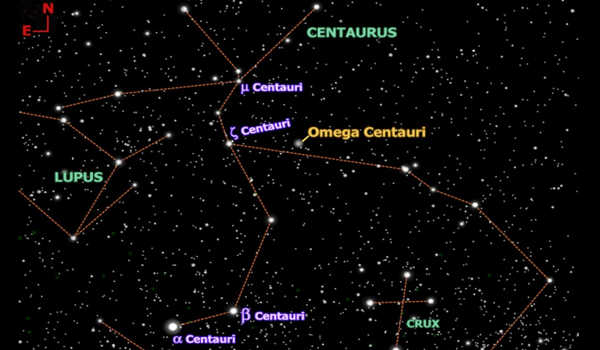Omega Centauri is a globular cluster in the constellation Centaurus that Edmond Halley discovered in 1677 as a non-stellar object. It is the Milky Way’s largest globular star cluster, containing approximately 10 million stars. At a distance of 17,090 light-years (5,240 pc), it is the Milky Way’s largest known globular cluster, with a diameter of about 150 light-years. It is estimated to contain approximately 10 million stars and a total mass of 4 million solar masses, making it the Milky Way’s most massive known globular cluster.
Omega Centauri is so different from most other galactic globular clusters that it’s thought to be the core remnant of a disrupted dwarf galaxy. Scientists concluded that the stars in Omega Centauri would interact with each other too frequently for stable habitable planets to exist.
Observation history
Ptolemy, a Greco-Roman writer, and astronomer cataloged this object as a star on the horse’s back in his Almagest in 150 AD, “Quae est in Principio scapulae.” With his 1603 publication of Uranometria, German lawyer and cartographer Johann Bayer used Ptolemy’s data to designate this object “Omega Centauri.” English astronomer Edmond Halley rediscovered this object in 1677 using a telescope from the South Atlantic island of Saint Helena, listing it as a non-stellar object. Halley included it in his list of six “luminous spots or patches” in the Philosophical Transactions of the Royal Society in 1716.
Omega Centauri was included in Swiss astronomer Jean-Philippe de Cheseaux’s 1746 list of 21 nebulae, as was French astronomer Lacaille in 1755, hence the catalog number L I.5. In 1826, Scottish astronomer James Dunlop identified it as a globular cluster, describing it as a “beautiful globe of stars very gradually and moderately compressed to the center.”

Properties
Omega Centauri, located approximately 17,090 light-years (5,240 pc) from Earth, is one of the few globular clusters visible to the naked eye—and appears nearly as large as the full Moon when viewed from a dark, rural area. It is the brightest, largest, and most massive known globular cluster associated with the Milky Way, weighing in at 4 million solar masses. Only Mayall II in the Andromeda Galaxy is brighter and more massive than the other globular clusters in the Local Group. Omega Centauri is about 12 billion years old and orbits the Milky Way. It contains several million Population II stars.
The stars in Omega Centauri’s core are so close together that they are only 0.1 light-years apart on average. The internal dynamics of 469 stars were studied using radial velocity measurements. The members of this cluster have a peak velocity dispersion of 7.9 km s1 as they orbit the center of mass. The mass distribution inferred from the kinematics is slightly longer than, but not significantly different from, the luminosity distribution.
















